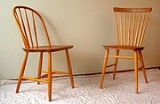
Refinishing
Encyclopedia

Woodworking
Woodworking is the process of building, making or carving something using wood.-History:Along with stone, mud, and animal parts, wood was one of the first materials worked by early humans. Microwear analysis of the Mousterian stone tools used by the Neanderthals show that many were used to work wood...
and the decorative art
Decorative art
The decorative arts is traditionally a term for the design and manufacture of functional objects. It includes interior design, but not usually architecture. The decorative arts are often categorized in opposition to the "fine arts", namely, painting, drawing, photography, and large-scale...
s, refinishing refers to the act of repairing or reapplying the wood finishing
Wood finishing
Wood finishing refers to the process of embellishing and/or protecting the surface of a wooden material. The process starts with surface preparation, either by sanding by hand , scraping, or planing. Imperfections or nail holes on the surface may be filled using wood putty or pores may be filled...
on an object. In practice, this may apply to the paint
Paint
Paint is any liquid, liquefiable, or mastic composition which after application to a substrate in a thin layer is converted to an opaque solid film. One may also consider the digital mimicry thereof...
or wood finish top coat, lacquer
Lacquer
In a general sense, lacquer is a somewhat imprecise term for a clear or coloured varnish that dries by solvent evaporation and often a curing process as well that produces a hard, durable finish, in any sheen level from ultra matte to high gloss and that can be further polished as required...
or varnish
Varnish
Varnish is a transparent, hard, protective finish or film primarily used in wood finishing but also for other materials. Varnish is traditionally a combination of a drying oil, a resin, and a thinner or solvent. Varnish finishes are usually glossy but may be designed to produce satin or semi-gloss...
. The artisan or restorer is traditionally aiming for an improved or restored and renewed finish. Refinishing can apply to a variety of surfaces and materials such as wood
Wood
Wood is a hard, fibrous tissue found in many trees. It has been used for hundreds of thousands of years for both fuel and as a construction material. It is an organic material, a natural composite of cellulose fibers embedded in a matrix of lignin which resists compression...
, glass
Glass
Glass is an amorphous solid material. Glasses are typically brittle and optically transparent.The most familiar type of glass, used for centuries in windows and drinking vessels, is soda-lime glass, composed of about 75% silica plus Na2O, CaO, and several minor additives...
, metal
Metal
A metal , is an element, compound, or alloy that is a good conductor of both electricity and heat. Metals are usually malleable and shiny, that is they reflect most of incident light...
, plastic
Plastic
A plastic material is any of a wide range of synthetic or semi-synthetic organic solids used in the manufacture of industrial products. Plastics are typically polymers of high molecular mass, and may contain other substances to improve performance and/or reduce production costs...
and paint
Paint
Paint is any liquid, liquefiable, or mastic composition which after application to a substrate in a thin layer is converted to an opaque solid film. One may also consider the digital mimicry thereof...
, although in Britain, when referring to wood or wooden furniture it is commonly known as repolishing.
There are a great variety of both traditional and modern finishes, including the use of faux
Faux painting
Faux painting or faux finishing are terms used to describe a wide range of decorative painting techniques. The naming comes from the French word faux, meaning false, as these techniques started as a form of replicating materials such as marble and wood with paint, but has subsequently come to...
finishes. One interesting modern development in refinishing is the art of distressing
Distressing
Distressing in the decorative arts is the activity of making a piece of furniture or object appear aged and older, and there are many methods to produce an appearance of age and wear. Distressing is viewed as a refinishing technique although it is the opposite of finishing in a traditional sense...
or antiquing, making the finishes of pieces look older.
While refinishing is often undertaken to salvage an old piece of furniture, in the case of antique furniture
Antique furniture
Antique furniture is the term for collectible interior furnishings of considerable age. Often its age, rarity, condition, utility, or other unique features makes a piece of furniture desirable as a collectors' item, and thus termed an "antique"....
refinishing has been known to significantly reduce the overall value of the piece. However, refinishing (or repolishing) a more modern piece of furniture, to return it to showroom condition, will always enhance the value.

